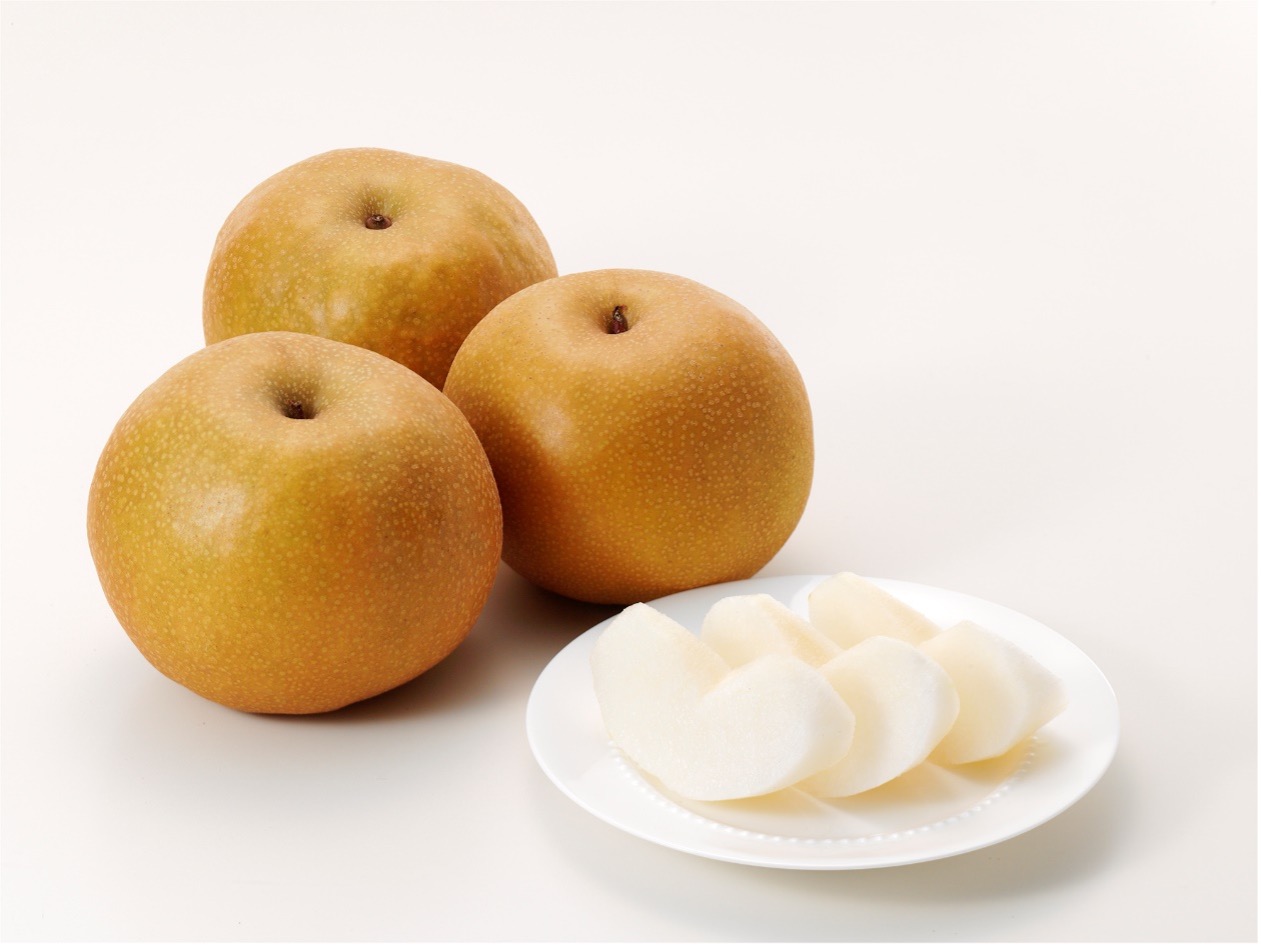Heavy Weight as Proof of Luscious Juice: The Golden “Kaga-shizuku” That Passes Strict Standards.
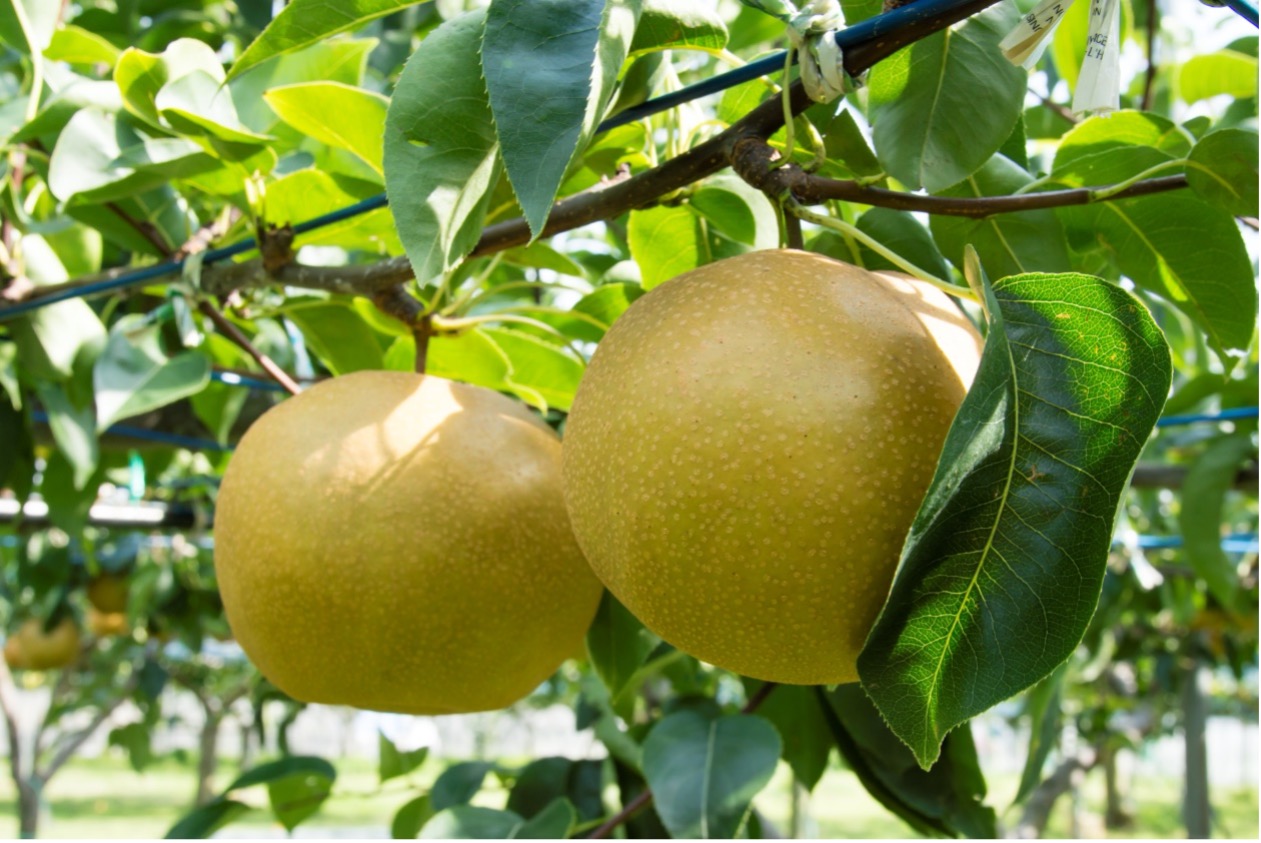
Boasting Exceptional Sweetness: About 1.5 Times the Size of a Typical Pear!
Ishikawa Prefecture’s brand pear, “Kaga-shizuku,” is grown in the cities of Kanazawa, Kaga, and Hakusan. It is available in the market from late August to mid-September and is appreciated as a special seasonal delicacy during this time.
“Kaga-shizuku” is a variety born from the cross between the difficult-to-cultivate “Kuratsuki,” produced only in certain parts of Ishikawa Prefecture, and “Kosui.” It was developed through over 16 years of research and improvement at the Ishikawa Agriculture and Forestry Research Center. Debuting in 2017, it quickly gained popularity and has continued to grow in recognition. The brownish skin and large size give it a strong presence. When held, it has a hefty weight. While the typical pear variety weighs around 400g each, “Kaga-shizuku” weighs around 600g, and some even exceed 800g, which is truly amazing.
Not only is its size impressive, but its sweetness is unsurpassed. It is shipped with a higher sugar content standard than the familiar “Kosui” variety. The highest rank, “Kaga-shizuku Premium,” follows an even stricter sugar content standard, making its sweetness truly exceptional.
How, in fact, is the large and sweet “Kaga-shizuku” actually grown?
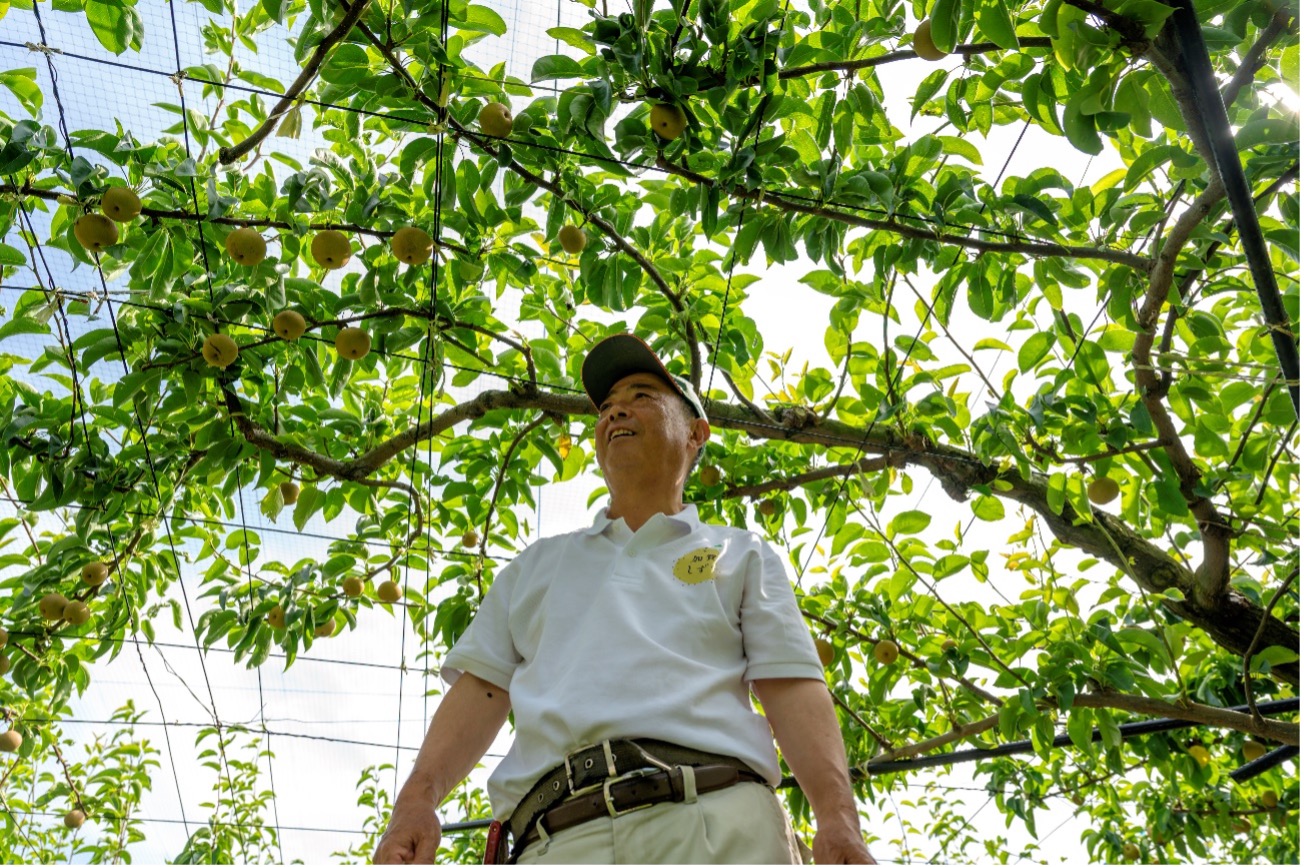
“Kaga-shizuku” is a Bit of a “Demanding” Variety. That’s Why It’s So Worth the Effort to Cultivate.
The seedlings of “Kaga-shizuku” are grafted and cultivated at the Ishikawa Agriculture and Forestry Research Center, then supplied to farmers. In each producer’s field, the seedlings are planted from December to early spring, and it takes about three years for them to bear fruit. “The key is to first grow the branches as much as possible and nurture the tree to a large size,” says Satoru Shimoda, president of the “Kaga-shizuku Research Association.” Mr. Shimoda grows “Kaga-shizuku” alongside peaches and other pear varieties in his orchard in the mountainous area of Kanazawa.
“Kaga-shizuku” tends to produce fewer branches and smaller leaves than other common varieties. Mr. Shimoda prioritizes tree growth because the more leaves there are, the more photosynthesis can occur, allowing the tree to store plenty of nutrients in the fruit. “You have to ensure that the nutrients are evenly distributed to the fruit, so even when I thicken the branches, I make sure the branches are not thicker than the main trunk,” he says with a smile. “‘Kaga-shizuku’ is a bit of a ‘demanding’ variety compared to other pears.”
In 2023, there were 96 producers of “Kaga-shizuku” in the prefecture. In recent years, the producers have been passing the baton to the next generation, and it seems that the number of younger producers is gradually increasing.
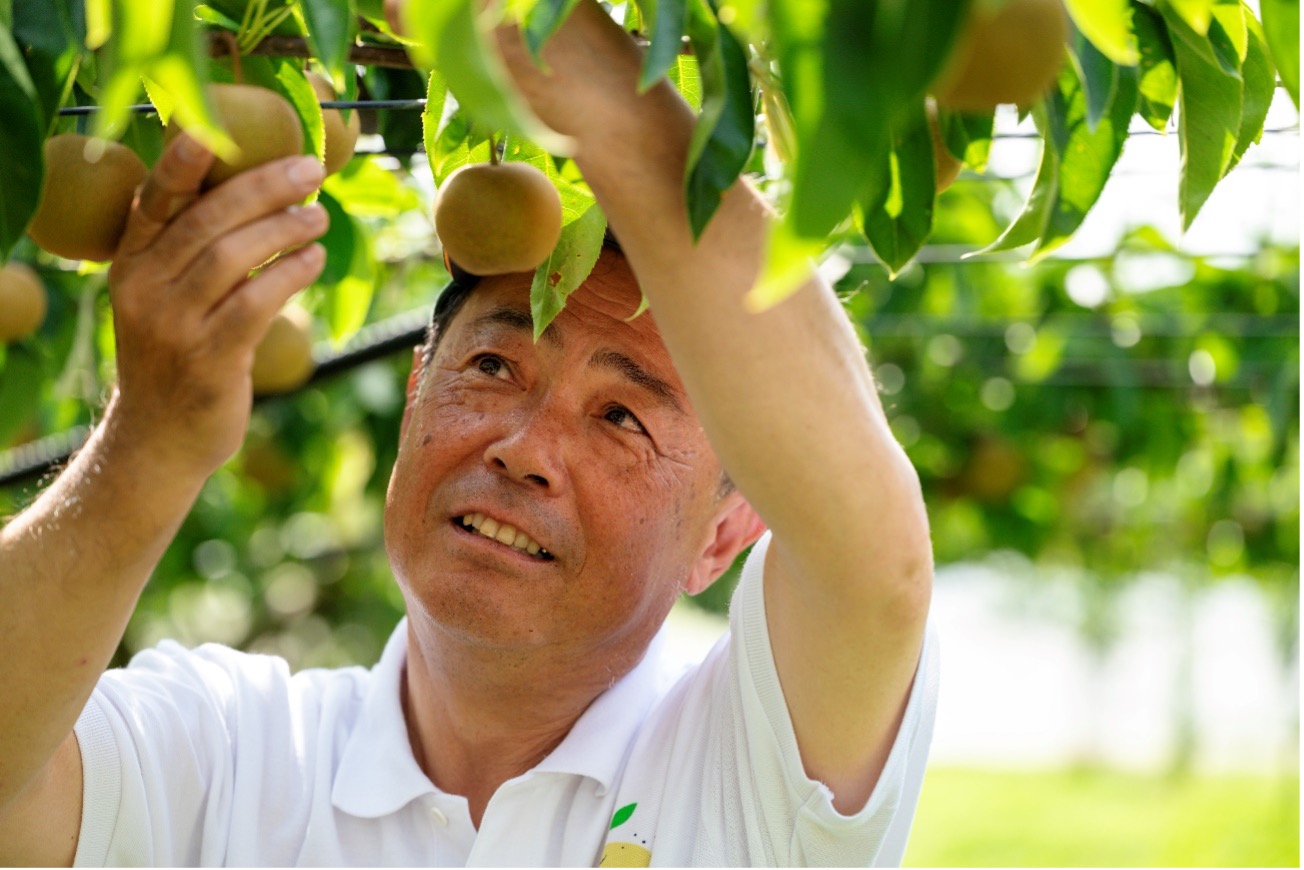
Carefully Assessing the Order of Flowering for Pollination. Also Mindful of “Sensitive Skin.”
Once the tree has reached a certain size and the cherry blossom-like flowers bloom in April, pollination is carefully performed by hand to ensure proper fruiting. The key is to “judge the order in which the flowers bloom.” Pear flowers bloom in clusters, but not all are pollinated. Mr. Shimoda says he has learned over time which flowers to pollinate to produce the best fruit.
In May and June, the fruit reaches a size of about 5 cm. At this stage, fruits with poor shape or those with holes from hail are prioritized for thinning. Fruits that have been deformed by bumping into branches or those that may be stuck together, potentially allowing insects to enter, are also subject to thinning. “Kaga-shizuku has ‘sensitive skin,’ so even the smallest injury cannot be overlooked. You have to remove those that might be damaged early on. You have to imagine what the fruit will look like once it has grown,” says Mr. Shimoda with a serious expression.
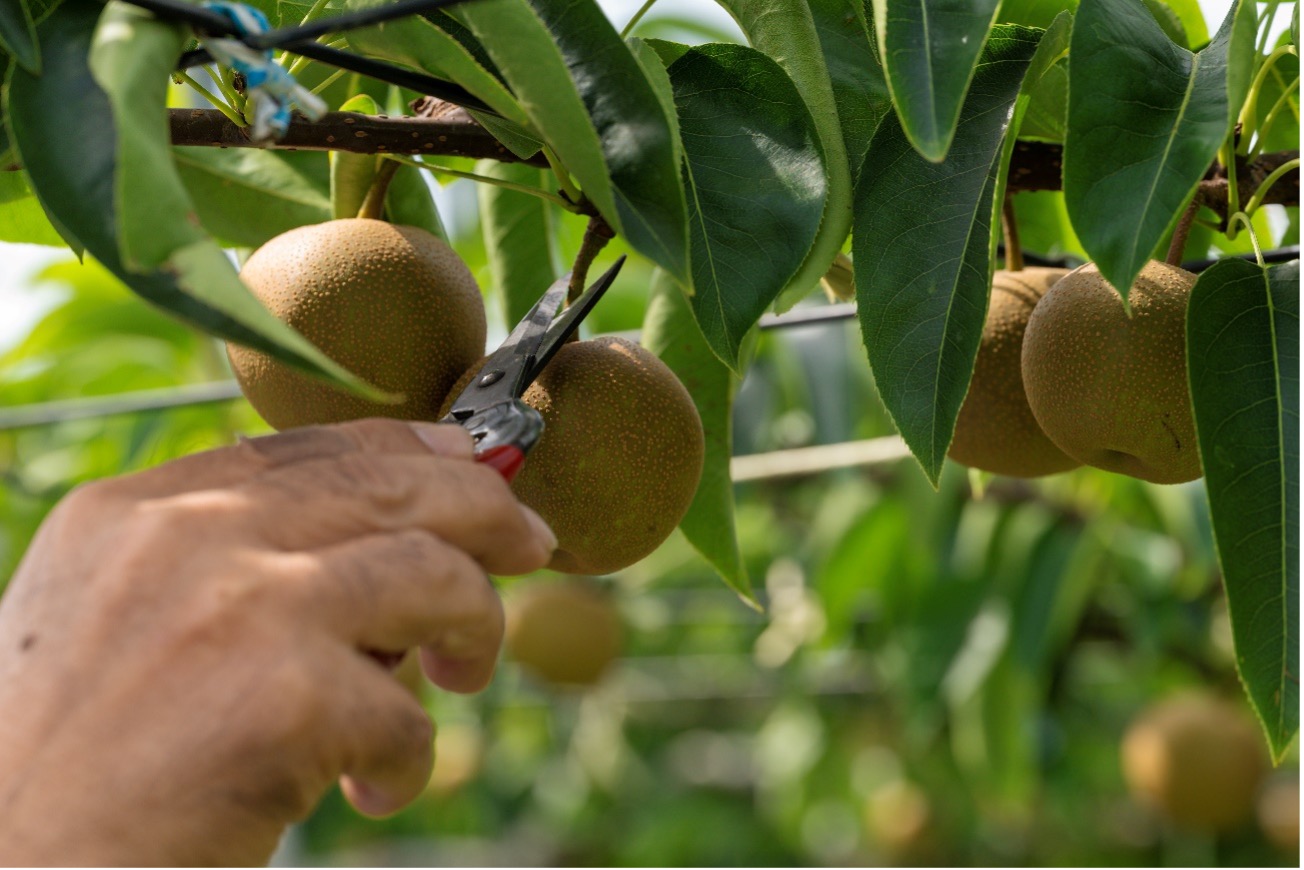
Limit the Number of Fruits Per Tree to Focus Sweetness and Nutrients on Each Fruit.
Thinning out the fruit is a crucial process for “Kaga-shizuku.” Compared to common pears such as “Kosui,” “Kaga-shizuku” undergoes stricter thinning, limiting the number of fruits that are allowed to grow. This ensures that each fruit receives enough nutrients, which enhances its sweetness. Ultimately, the number of fruits per tree is adjusted to about 60% of that of typical pears.
In addition to thinning the fruit, branches are occasionally pruned, and the amount of foliage is adjusted to ensure that the fruit receives an appropriate amount of sunlight. In this way, each producer carefully takes care of the tree, allowing “Kaga-shizuku” to slowly increase its sugar content and grow larger.
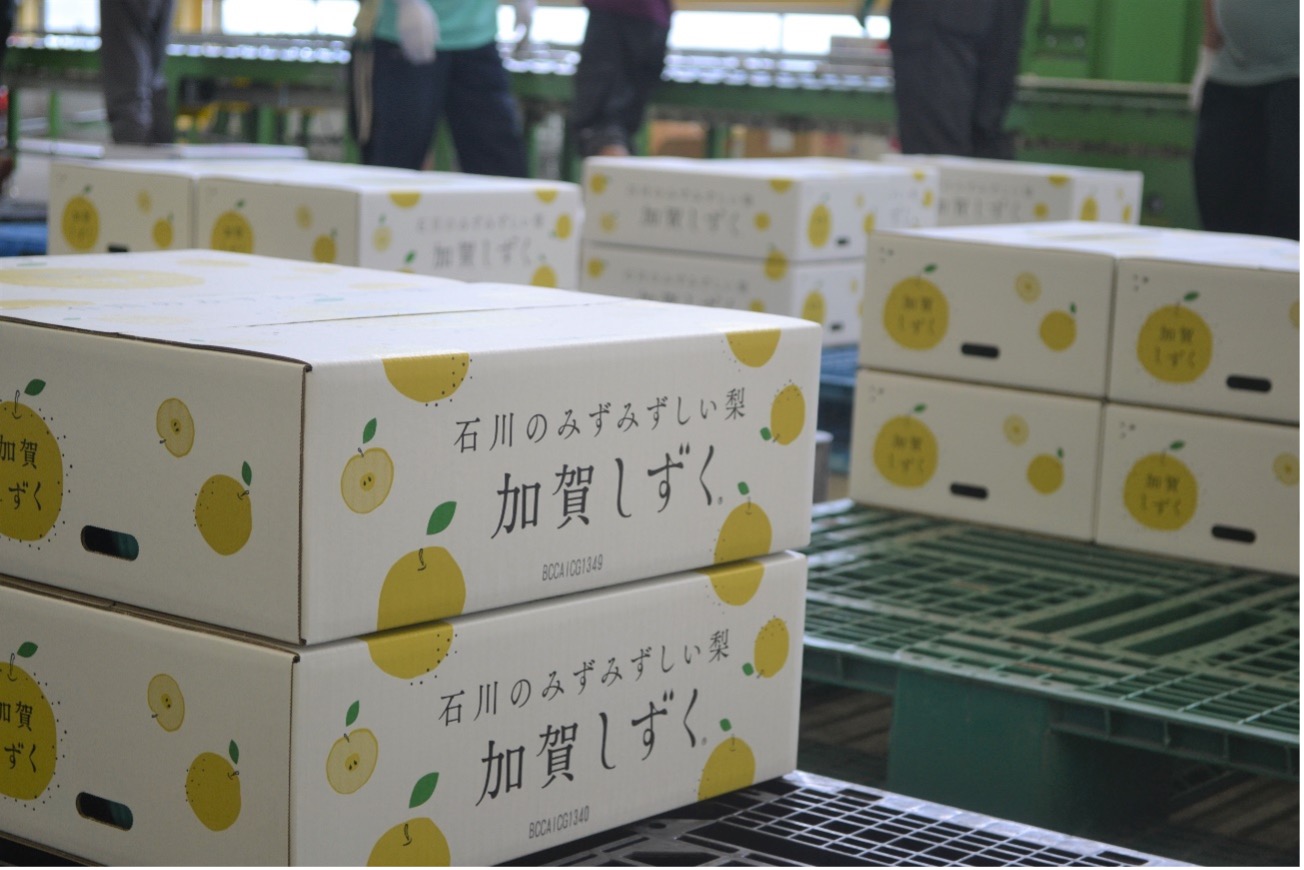
Precisely Measuring Sugar Content and Size With Specialized Equipment.
Pears are usually graded according to unique shipping standards set by each production area, such as Kanazawa City and Kaga City. However, “Kaga-shizuku” is produced according to the same standards in all areas of the prefecture, ensuring a consistent brand identity. Mr. Shimoda explains, “In other prefectures, pears that would be classified as ‘excellent’ (‘秀’) might only be classified as ‘good’ (‘優’) in Kanazawa. Kanazawa’s pear ranking system is extremely strict, and ‘Kaga-shizuku’ is held to even more detailed standards.” As Mr. Shimoda notes, “Kaga-shizuku” is particularly known for its strict criteria regarding sugar content and size.
At the grading facility, the sugar content and size of each pear are measured individually by specialized equipment that does not harm the fruit. Based on these measurements, the pears are classified into three ranks: “Premium” (プレミアム), “Special Excellent” (特秀), and “Excellent” (秀). This machine is highly precise, and if the sugar content falls even 0.1 degrees below the standard, the pear is disqualified from the ranking.
At the grading facility, the sugar content of each “Kaga-shizuku” is displayed on a screen, and when a particularly high reading is recorded, a murmur of excitement fills the room. Mr. Shimoda says, “It’s definitely exciting when a pear is selected as ‘Premium.’ That’s why I’m always nervous at the grading facility.” He adds that only a few percent of the pears in the entire prefecture qualify as “Premium,” making them truly rare and precious.
After going through this process, “Kaga-shizuku” is finally shipped and arrives on our dining tables.

Chill Well and Enjoy the Juicy Flavor.
The best way to enjoy it is, without a doubt, by eating it fresh. Mr. Shimoda also recommends, “Chill it in the refrigerator overnight and enjoy it cold.” It has a mild tartness and a refined sweetness. The juicy, smooth texture fills the mouth with flavor—just like the freshness that inspired the name "Kaga-shizuku," its refreshing juiciness will cool and quench your thirst in the increasingly harsh late summer heat.
“Kaga-shizuku” holds great potential as a relatively new variety of pear. Mr. Shimoda's orchard has seen an increase in production year after year. “In my orchard, the production of other pear varieties even exceeds that of ‘Kaga-shizuku,’ but we grow ‘Kaga-shizuku’ with a focus on its exceptional taste and with pride as a brand of Ishikawa Prefecture. I hope that in the future, people not only in the prefecture but all over the country will be able to enjoy it.”
